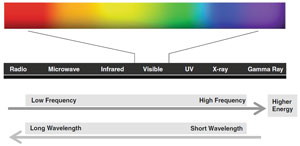| Table 3-32 Comparison of UVA and UVB |
| Factors | | UVA | | UVB |
| | Wavelength | | 315–400 nm 290–315 nm
(UVA1: 340–400, UVA2: 315–340) | | 290–315 nm |
| | Solar erythema
(sunburn) | | Minor role; immediate erythema and distinct delayed erythema (6–24 h after exposure) | | Major role; 6–24 h after exposure; UVB 1000× more erythemogenic than UVA; produces apoptotic ‘sunburn’ cell |
| | Skin penetration | | Epidermis through deep dermis (epidermal/dermal chromophores) | | Epidermis only (fraction reaches upper dermis); causes epidermal thickening |
| | Darkening | | Immediate pigment darkening (hrs after exposure; due to oxid ation of pre-existing melanin, redistribution of melanosomes) | | Delayed melanogenesis (48–72 h after exposure) due to ↑ # melanocytes, ↑ #/size melanosomes, ↑ synthesis/transfer melanin; provides photoprotection |
| | Drug-induced
photosensitivity | | Major contributor | | Minor role |
| | Carcinogenesis | | Minor role; ROS production | | Major role: mutations in keratinocyte DNA (CPDs) and immunosuppression |
| | Vit D3 production | | No | | Yes |
| | Glass penetration | | Yes (penetrates window glass) | | No |
| | Miscellaneous | | 95% of UVR reaching earth’s surface, phytophotodermatitis | | NBUVB 313 nm; Wood’s light ~365 nm (nickel oxide doped glass) |
| | | | | | |
| | | | | | |
| | | | | | | | | | | | | UVA: Drug-induced photosensitivity, photoaging, immediate pigment darkening, erythema | | | | | | | | |
| | | | | | | | | | | UVB: Photocarcinogensis, solar erythema, delayed pigment darkening, vitamin D3 synthesis | | | | | | | | |
|
